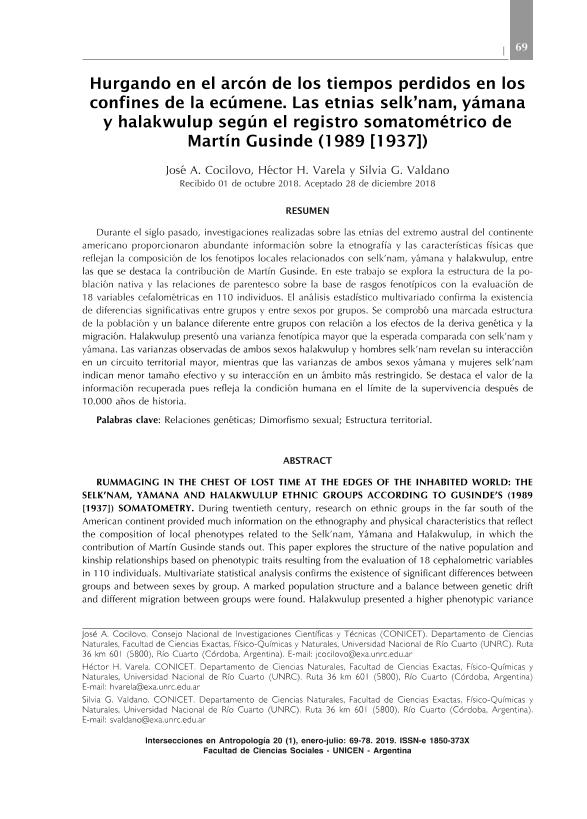Artículo
Durante el siglo pasado, investigaciones realizadas sobre las etnias del extremo austral del continente americano proporcionaron abundante información sobre la etnografía y las características físicas que reflejan la composición de los fenotipos locales relacionados con selk'nam, yámana y halakwulup, entre las que se destaca la contribución de Martín Gusinde. En este trabajo se explora la estructura de la población nativa y las relaciones de parentesco sobre la base de rasgos fenotípicos con la evaluación de 18 variables cefalométricas en 110 individuos. El análisis estadístico multivariado confirma la existencia de diferencias significativas entre grupos y entre sexos por grupos. Se comprobó una marcada estructura de la población y un balance diferente entre grupos con relación a los efectos de la deriva genética y la migración. Halakwulup presentó una varianza fenotípica mayor que la esperada comparada con selk'nam y yámana. Las varianzas observadas de ambos sexos halakwulup y hombres selk'nam revelan su interacción en un circuito territorial mayor, mientras que las varianzas de ambos sexos yámana y mujeres selk'nam indican menor tamaño efectivo y su interacción en un ámbito más restringido. Se destaca el valor de la información recuperada pues refleja la condición humana en el límite de la supervivencia después de 10.000 años de historia. During twentieth century, research on ethnic groups in the far south of the American continent provided much information on the ethnography and physical characteristics that reflect the composition of local phenotypes related to the Selk’nam, Yámana and Halakwulup, in which the contribution of Martín Gusinde stands out. This paper explores the structure of the native population and kinship relationships based on phenotypic traits resulting from the evaluation of 18 cephalometric variables in 110 individuals. Multivariate statistical analysis confirms the existence of significant differences between groups and between sexes by group. A marked population structure and a balance between genetic drift and different migration between groups were found. Halakwulup presented a higher phenotypic variance than expected compared with Selk’nam and Yámana. The observed variances of both sexes among the Halakwulup and Selk’nam men reveal their interaction in a larger territorial circuit, while the variances of both sexes among the Yámana and Selk’nam women indicate a smaller effective size and their interaction in a more restricted environment. The value of the study is that it highlights the human condition at the limit of survival after 10,000 years of history.
Hurgando en el arcón de los tiempos perdidos en los confines de la ecúmene. Las etnias selk'nam, yámana y halakwulup según el registro somatométrico de Martín Gusinde (1989 [1937])
Título:
Rummaging in the chest of lost time at the edges of the inhabited world: the selk’nam, yámana and halakwulup ethnic groups according to gusinde’s (1989 [1937]) somatometry
Fecha de publicación:
13/09/2019
Editorial:
Universidad Nacional del Centro de la Provincia de Buenos Aires. Facultad de Ciencias Sociales
Revista:
Intersecciones en Antropología
ISSN:
1666-2105
e-ISSN:
1850-373X
Idioma:
Español
Tipo de recurso:
Artículo publicado
Clasificación temática:
Resumen
Palabras clave:
RELACIONES GENÉTICAS
,
DIMORFISMO SEXUAL
,
ESTRUCTURA TERRITORIAL
Archivos asociados
Licencia
Identificadores
Colecciones
Articulos (ICBIA)
Articulos de INSTITUTO DE CIENCIAS DE LA TIERRA, BIODIVERSIDAD Y AMBIENTE
Articulos de INSTITUTO DE CIENCIAS DE LA TIERRA, BIODIVERSIDAD Y AMBIENTE
Articulos(CCT - CORDOBA)
Articulos de CTRO.CIENTIFICO TECNOL.CONICET - CORDOBA
Articulos de CTRO.CIENTIFICO TECNOL.CONICET - CORDOBA
Citación
Cocilovo, Jose Alberto; Varela, Hector Hugo; Valdano, Silvia; Hurgando en el arcón de los tiempos perdidos en los confines de la ecúmene. Las etnias selk'nam, yámana y halakwulup según el registro somatométrico de Martín Gusinde (1989 [1937]); Universidad Nacional del Centro de la Provincia de Buenos Aires. Facultad de Ciencias Sociales; Intersecciones en Antropología; 20; 1; 13-9-2019; 69-78
Compartir




